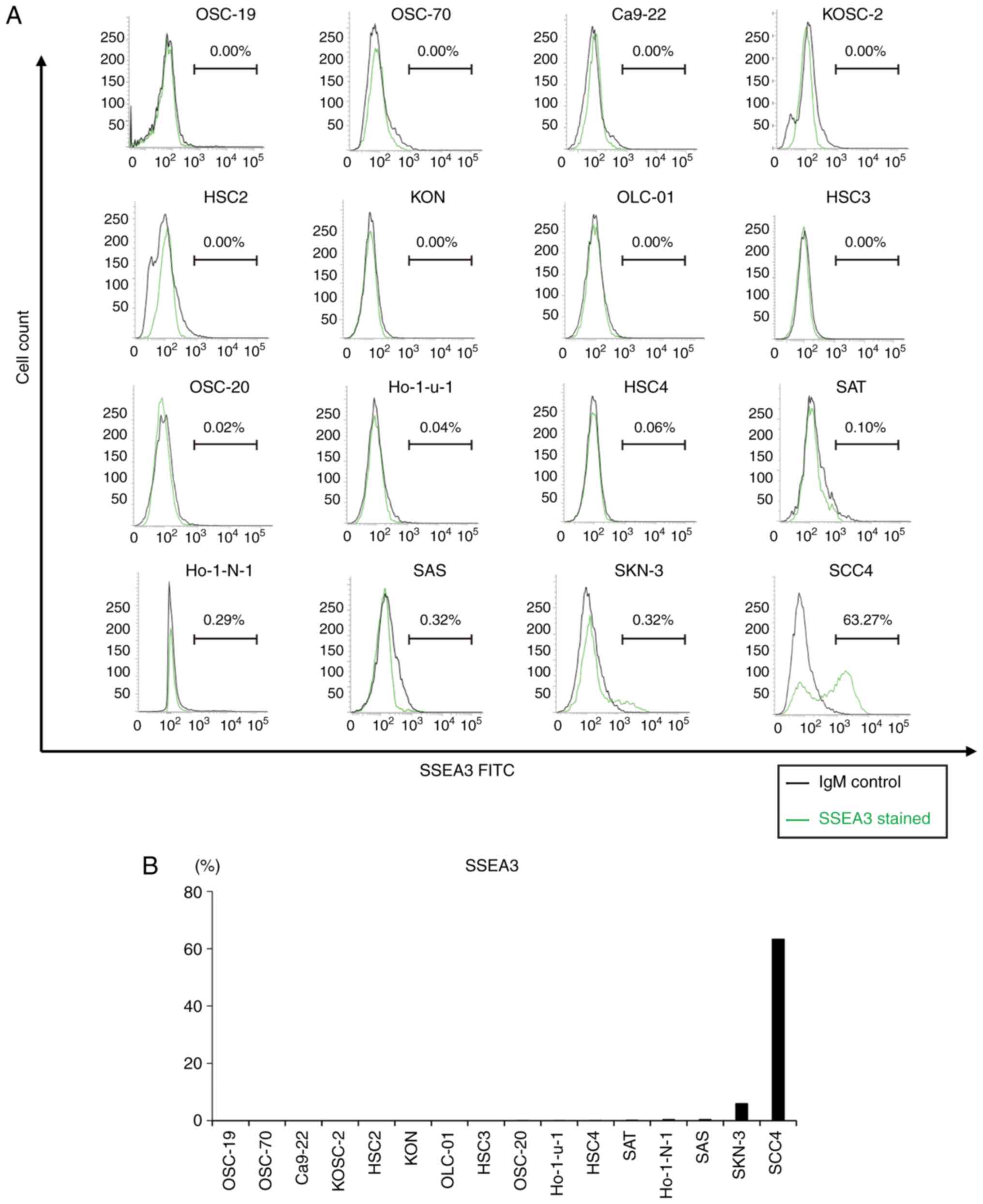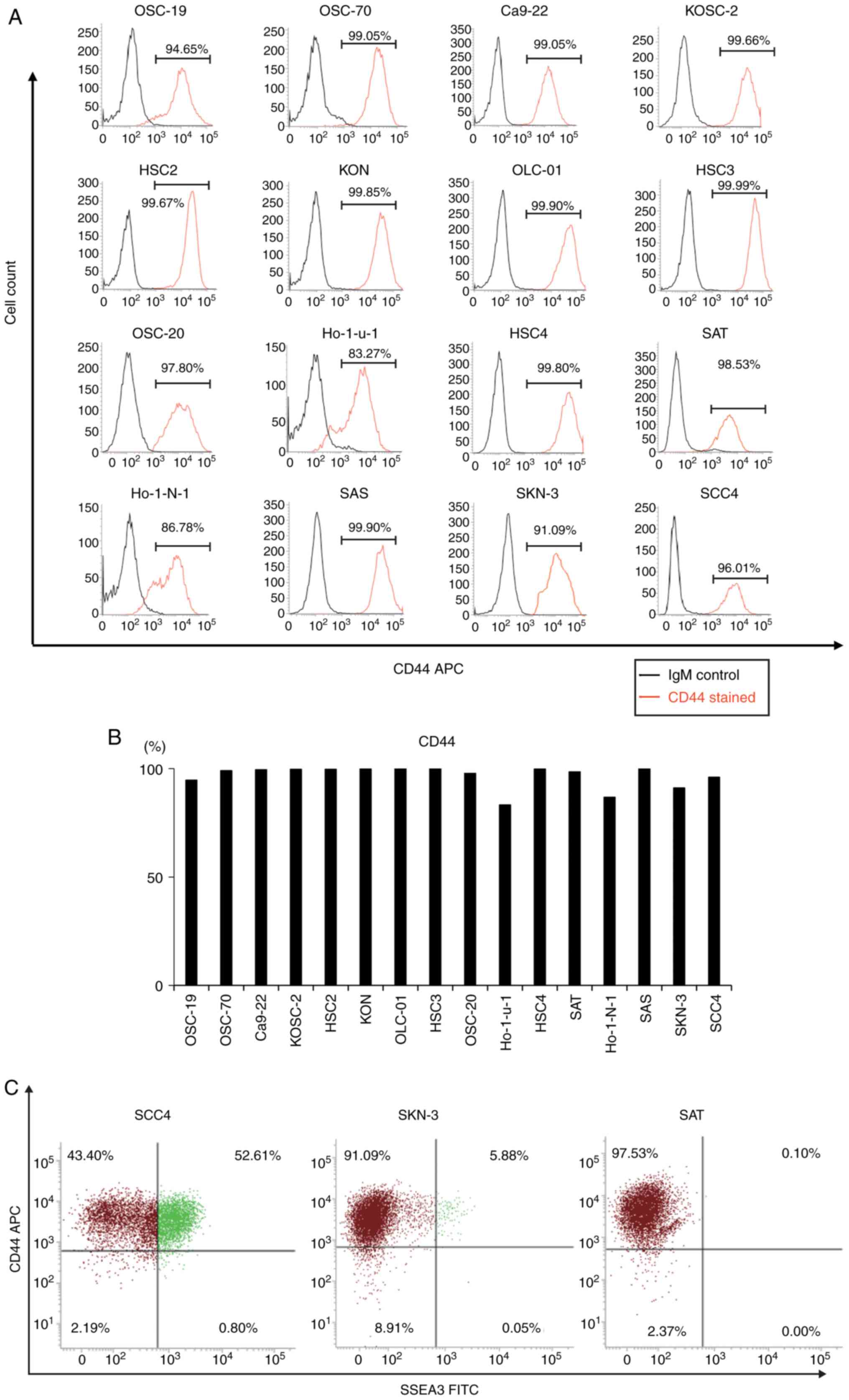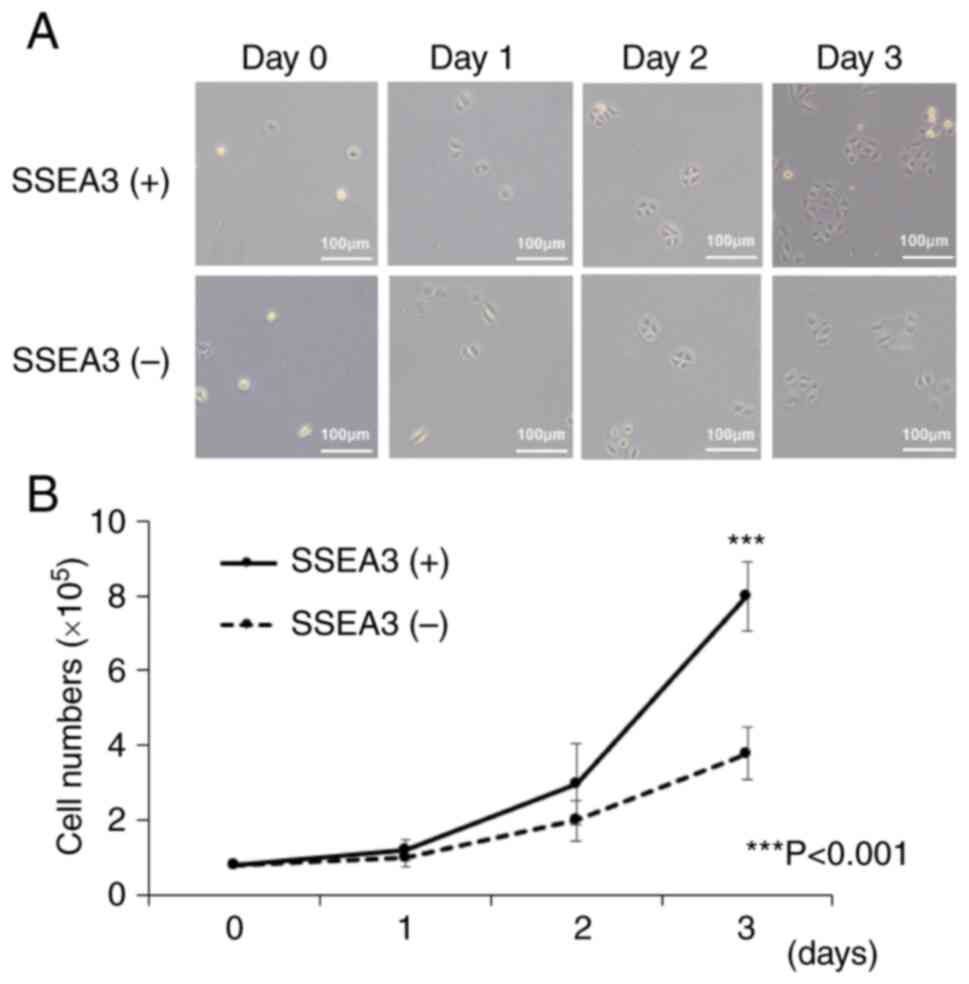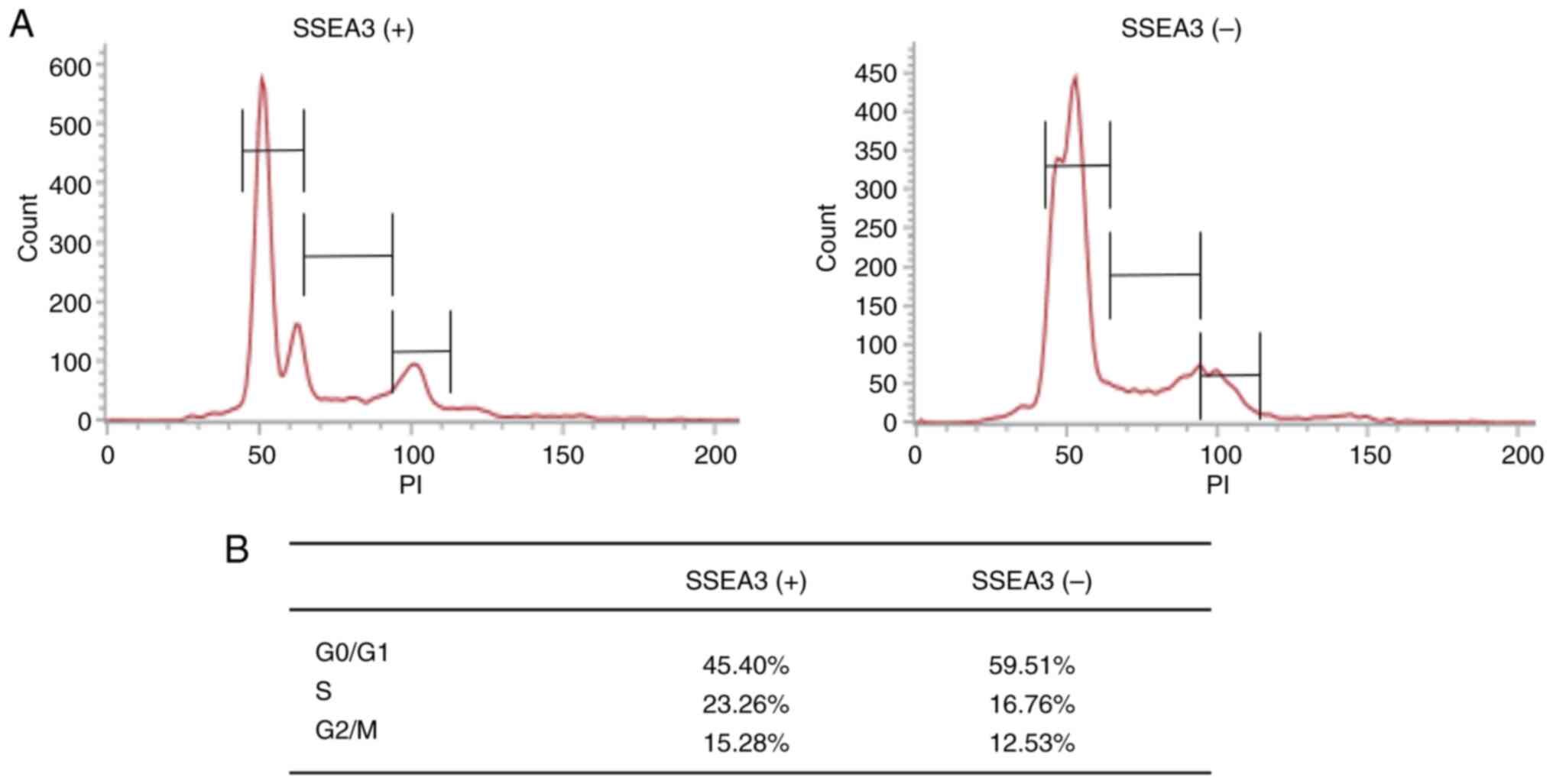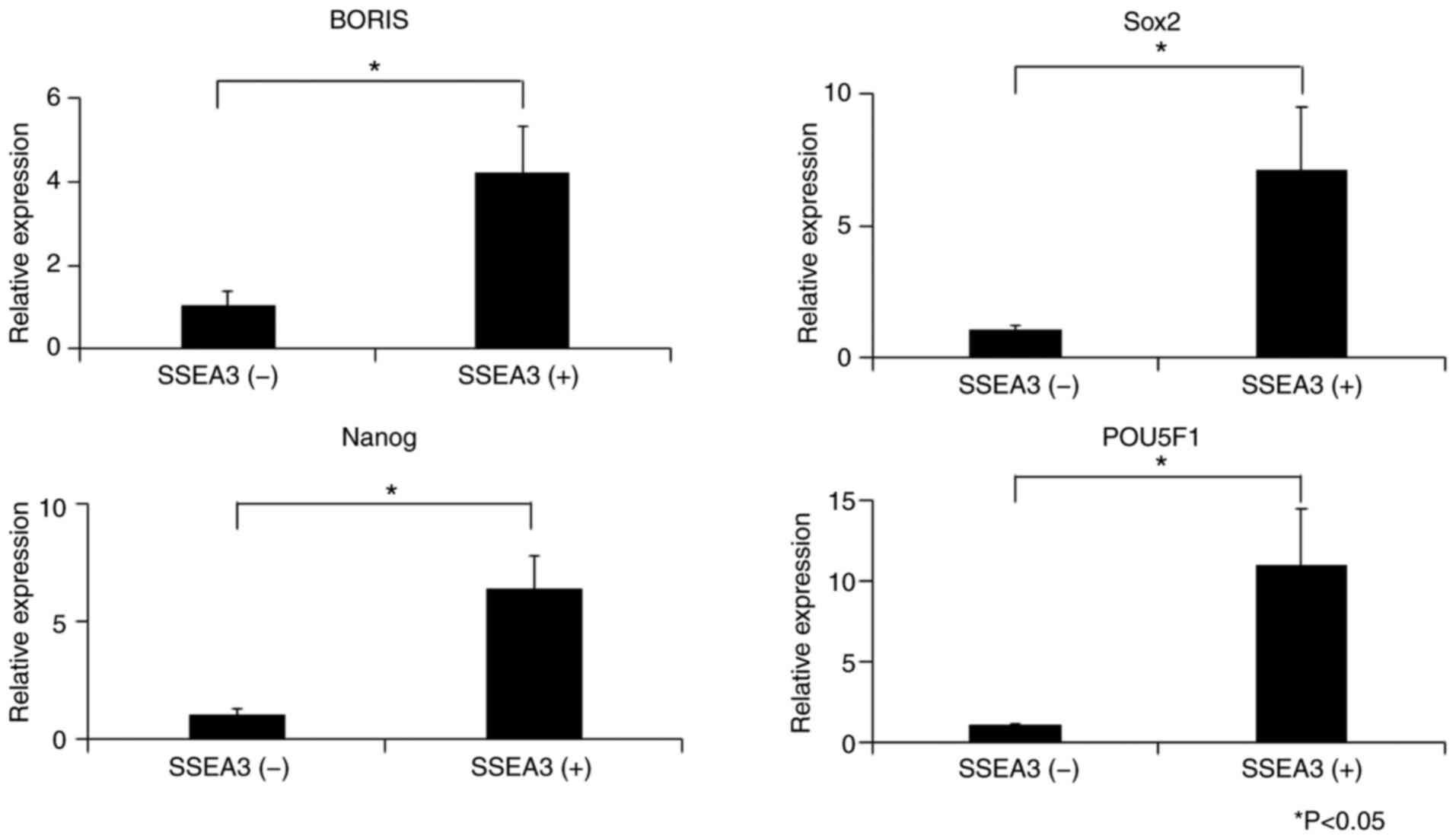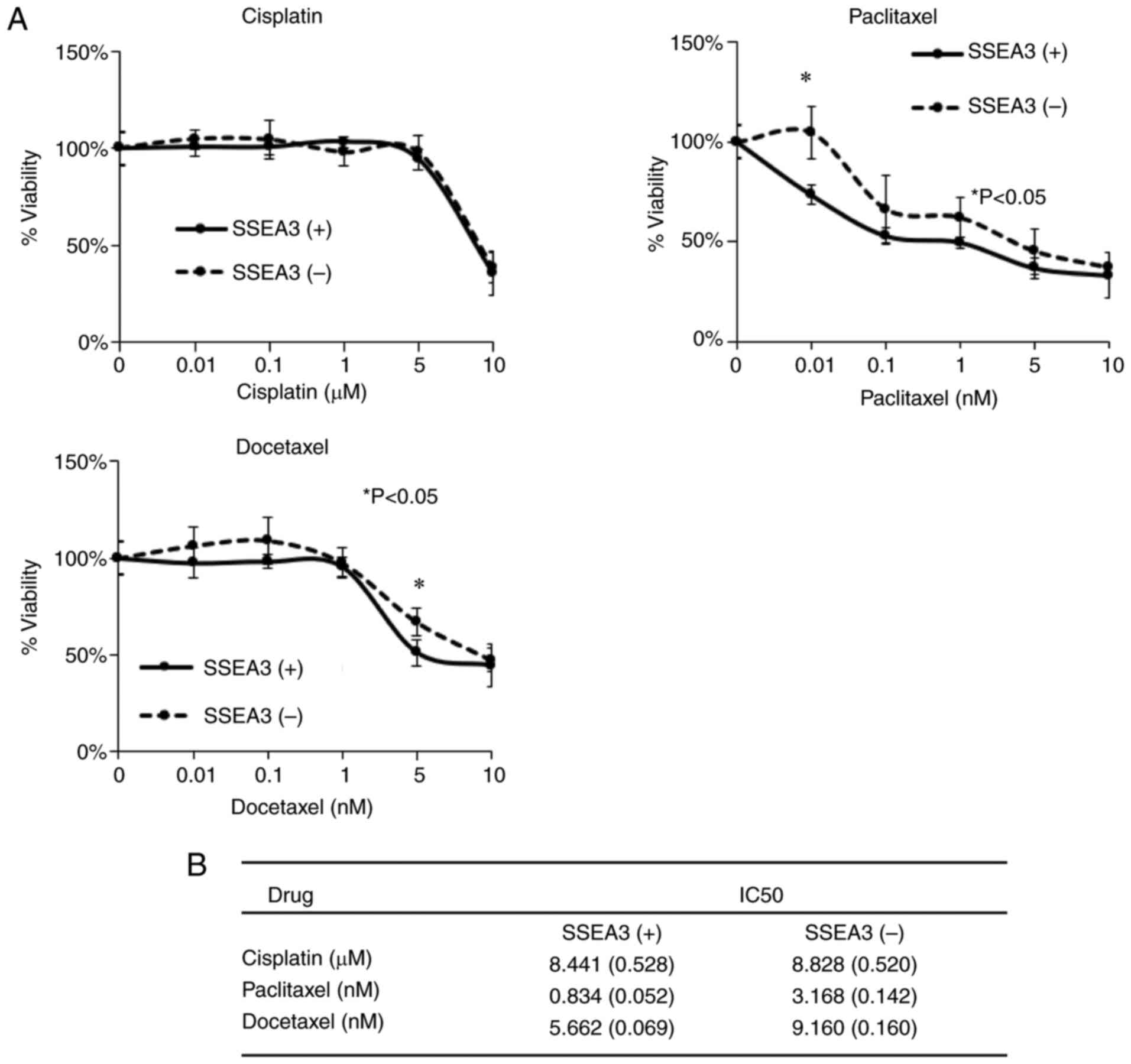Exploring stage‑specific embryonic antigen 3 involvement in oral cancer progression and as a potential target for taxane‑based chemotherapy
- Authors:
- Published online on: August 22, 2023 https://doi.org/10.3892/or.2023.8619
- Article Number: 182
-
Copyright: © Ide et al. This is an open access article distributed under the terms of Creative Commons Attribution License.
Abstract
Introduction
Neoplasms, or abnormal growths, are complex diseases. They result from an accumulation of genetic and epigenetic abnormalities, leading to uncontrolled cell proliferation, infiltration and metastasis (1–3). Among these diseases, head and neck squamous cell carcinoma (HNSCC) stands out due to its prevalence. It is the sixth most common neoplasm worldwide, making up ~4% of all malignancies (4–6). Despite significant progress in cancer research, the outlook for patients with advanced HNSCC remains poor. The 5-year survival rate is ~50% (7–10). This highlights the urgent need for new therapeutic targets for HNSCC. One promising area of focus is cancer stem cells (CSCs). They are considered to drive tumor initiation, progression and recurrence (6,11–15). CSCs are a small subset of cells within a tumor that possess the capacity for self-renewal and the ability to give rise to the heterogeneous lineages of cancer cells that comprise the tumor. They are considered to be responsible for the initiation, propagation and recurrence of cancer. CSCs are also often resistant to conventional chemotherapeutic drugs and radiation therapy, which can lead to the recurrence of tumors after treatment.
CD44 is the most frequently reported CSC marker. Its expression is associated with poor prognosis and resistance to therapy (13–16). The CD44 antigen is a multifunctional cell surface glycoprotein involved in cell-cell interactions, cell adhesion, and migration. It is encoded by the CD44 gene located on chromosome 11 in humans. CD44 is a receptor for hyaluronic acid (HA) and can also interact with other ligands, such as osteopontin, collagens and matrix metalloproteinases (17,18). CD44 interaction with HA plays a significant role in numerous biological activities including lymphocyte activation, recirculation and homing, hematopoiesis and tumor metastasis (19). In the context of HNSCC, CD44 is the most frequently reported CSC marker. CD44-positive (+) cells in HNSCC have been revealed to exhibit stem cell properties, such as self-renewal and tumorigenicity. The expression of CD44 in HNSCC is associated with poor prognosis and resistance to therapy. Nevertheless, the pursuit of supplementary indicators to delineate CSCs and elucidate their characteristics persists. This endeavor transcends mere scholarly interest, as it holds the potential to engender groundbreaking and efficacious therapies for cancer, capable of eradicating neoplastic cells and impeding their reappearance.
One such potential marker is the stage-specific embryonic antigen 3 (SSEA3). This glycosphingolipid molecule is an important marker for mammalian cells that display pluripotent and stem cell-like characteristics (20–22). However, the expression and function of SSEA3 in HNSCCs remain unclear. This gap forms the basis of the present study. The objective of the present study was to examine the expression of SSEA3 and its potential role in modulating CSC properties. This includes cellular proliferation stemness, and drug resistance in CD44(+) cells within an oral cancer cell line. The present study is crucial as it could contribute to enhance the understanding of the role of SSEA3 in HNSCC; thus, patients suffering from this life-threatening disease will be able to improve their outcomes and survival rates.
Materials and methods
Cell lines
The human oral neoplastic cell lines, OSC-19 (cat. no. 0198), OSC-20 cells (cat. no. 0197), SCC4 (cat. no. 9118), SAS (cat. no. 0260), HSC2 (cat. no. 0622), HSC3 (cat. no. 0623), HSC4 (cat. no. 0624), KOSC-2 (cat. no. 0126.1), KON (cat. no. 0194), Ca9-22 (cat. no. 0625), HO-1-u-1 (cat. no. 0828), HO-1-N-1 (cat. no. 0831), SAT (cat. no. 1027) and SKN-3 (cat. no. 1039) were obtained from the Japanese Collection of Research Bioresources (JCRB) Cell Bank. The aforementioned cell lines were authenticated by JCRB Cell Bank using STR methods. The other human oral neoplastic cell lines, OLC-01 (23) and OSC-70 (24) were gifted from Dr S. Kawashiri (Kanazawa University, Kanazawa, Japan). All cell lines were cultured in high glucose DMEM (Sigma-Aldrich; MilliporeSigma) supplemented with 10% heat-inactivated fetal bovine serum (FBS) at 37°C in a humidified atmosphere containing 5% CO2.
Flow cytometric assessment of CD44 and SSEA3
The assessment of CD44 and SSEA3 was conducted through a process of flow cytometry. This process was facilitated by the use of BD FACSVerse™ Flow Cytometer (cat. no. 651155, version 1.1), which was sourced from BD Biosciences. Before the assessment, the cells were dissociated with Accutase (cat. no. AT104; Invitrogen; Thermo Fisher Scientific, Inc.) and washed with ice cold PBS. A number of the cells was adjusted to a concentration of 1.0×106 cells/ml in ice cold FACS Buffer (PBS, 1% BSA; cat. no. BR-220701651; Biomedical Science, Co., Ltd.). A total of 500 µl cell suspension was stained with a primary antibody that is a rat anti-human SSEA3 monoclonal antibody (MC-631; 1:100; cat. no. MA1-020; Thermo Fisher Scientific, Inc.) and incubated for 30 min at 4°C. After incubation, the cells were washed with ice cold PBS by centrifugation at 200 × g for 5 min and resuspended in 500 µl ice cold FACS Buffer. The cells were stained with the following secondary antibodies: allophycocyanin (APC)-labeled mouse anti-CD44 monoclonal antibody (MEM-85; 1:500; cat. no. ab239294; Abcam) and fluorescein isothiocyanate (FITC)-labeled goat anti-rat IgM polyclonal antibody (1:500; cat. no. 112-095-075; Jackson ImmunoResearch Laboratories, Inc.) and kept at 4°C in a fridge for 30 min. After incubation and washing with PBS, the cells were stained with SYTOX™ Blue Dead Cell Stain (1:500: cat. no. S34857; Invitrogen; Thermo Fisher Scientific, Inc.) to differentiate between viable and nonviable cells. In the flow cytometric analysis, purified rat IgM k isotype control monoclonal antibody (1:100; cat. no. 400801; BioLegend, Inc.) and purified mouse IgG2b k isotype control monoclonal antibody (1:100; cat. no. 202201; BioLegend, Inc.) were used as control primary antibody. These controls were obtained from BD Pharmingen; BD Biosciences. This comprehensive process of flow cytometric assessment allowed for a detailed and accurate appraisal of CD44 and SSEA3 in the cells. Each positive cell population in the entire oral cancer cell population has been analyzed. Values were expressed as percentages.
Isolation of SSEA3 (+) and SSEA3 negative (−) cell populations via cell sorting
The isolation of SSEA3 positive (+) and SSEA3 negative (−) cell populations was achieved through a process of cell sorting. This process was facilitated by the use of a Sony SH800S Cell Sorter (Sony Biotechnology Inc.). The sorter was equipped with a 130-µm sorting chip, which was crucial for the segregation of cells. The SCC4 cell lines were prepared for sorting by staining them with a rat anti-human SSEA3 monoclonal antibody (Thermo Fisher Scientific, Inc.) and a goat anti-rat IgM (FITC) antibody (Jackson ImmunoResearch Laboratories, Inc.). This staining process was carried out strictly in accordance with the manufacturer's guidelines provided by Sony Biotechnology. Following the staining, the purity of the partitioned SSEA3(+) and SSEA3(−) cells was assessed. This assessment was carried out through flow cytometry, employing a FACS Verse instrument. The cells were labeled again with the rat anti-human SSEA3 monoclonal antibody and the goat anti-rat IgM FITC antibody for this assessment. Before the sorting process, the stained cells were filtered into a conical tube. A 35-µm nylon filter was used for this filtration process. The cell proliferation, cell cycle, reverse transcription-polymerase chain reaction and chemoresistance assay data reflecting SSEA3 expression were differentiated via cell sorting from SCC4. This comprehensive process ensured the isolation of the specific cell populations for further study.
Cell proliferation assessment
The study of cellular proliferation was conducted to compare the growth rates between various cellular samples. The procedure began with seeding 1×105 cells in each well of a six-well plate. The cell culture conditions were maintained at 37°C and atmosphere standard for cell growth, specifically within a 5% CO2 incubator. The growth medium utilized was DMEM, supplemented with 10% FBS to provide necessary nutrients for the cells. These conditions were maintained for a period ranging between 1 to 3 days, allowing for cells to undergo several rounds of proliferation. Post-incubation, the counting of cells was carried out using a Countess Automated Cell Counter (Invitrogen; Thermo Fisher Scientific, Inc.). This device facilitated the accurate and reliable quantification of cells in the sample. To enhance the reliability of the count and to reduce sample bias, a minimum of four different cell images from each well were randomly selected and captured with a phase-contrast microscope for independent verification. This ensured that the cell count was representative of the entire well, providing a more accurate measurement of cellular proliferation. These methods provided a comprehensive and precise examination of the cellular proliferation rates, eliminating any potential for misunderstanding and ensuring the reproducibility of the experiments.
Cell cycle analysis
The cell cycle analysis was conducted on SSEA3(+) and negative (−) cells, which were sorted from SCC4 cells. The sorted cells were first resuspended in a solution. This solution was prepared by adding 5 µl of Cell Cycle Assay Solution Blue kit (Dojindo Molecular Technologies, Inc.) to 500 µl of Phosphate-Buffered Saline. This resuspension process was carried out at a controlled temperature of 37°C for a duration of 15 min, strictly adhering to the guidelines provided by the manufacturer of the Cell Cycle Assay Solution Blue. After the resuspension, the cells were stained using the same solution. The stained cells were then assessed using a specific instrument known as BD FACSVerse™ Flow Cytometer. The assessment was followed by a filtration process. In this process, the cells were filtered into a conical tube. A 35-µm nylon filter was used for this purpose to ensure the collection of only the cells of interest. The entire process was carried out under sterile conditions to prevent any contamination. Percentage of cells in the G0/G1, S, and G2/M phases on SSEA3(+) or (−) cells from SCC4 cells has been analyzed.
RNA extraction, cDNA synthesis, and reverse transcription-quantitative PCR
The mRNA expression levels of brother of the imprinted site regulator (BORIS), sex-determining region Y-box 2 (SOX2), homeobox protein NANOG (Nanog), and octamer-binding transcription factor 4, also known as POU Class 5 Homeobox 1 (POU5F1) were analyzed using a Rotor-Gene Q 2plex System (Qiagen GmbH) with FAM/ZEN/IBFQ probes (Integrated DNA Technologies, Inc.). DNA sequences of pre-designed BORIS primer/probe (ref. 106829301, Hs.PT.58.50443006, NM_001269040, Integrated DNA Technology), pre-designed SOX2 primer/probe (ref. 105825433, Hs.PT.58.237897.g, NM_003106, Integrated DNA Technologies, Inc.), pre-designed Nanong primer/probe (ref. 105825437, Hs.PT.58.21480849, NM_024865, Integrated DNA Technology) and pre-designed POU5F1 primer/probe (ref. 105825441, Hs.PT.58.14648152.g, NM_203289, Integrated DNA Technology) were not available. Assay IDs and RefSeq accession numbers of the tested genes were provided. Total RNA was extracted from SCC4 cells using TRI Reagent (Merck KGaA) and a PureLink RNA Mini kit (Thermo Fisher Scientific, Inc.). cDNA was obtained using a PrimeScript 1st strand cDNA Synthesis kit (Takara Bio, Inc.). All reactions were performed in accordance with the manufacturer's instructions. All PCR reactions were performed on a Qiagen Rotor-Gene Q real-time PCR system with the following thermocycling conditions: Pre-incubation at 94°C for 2 min, followed by 40 cycles of 15 sec at 95°C and 1 min at 60°C. A total of 10 ng cDNA sample were used for the RT-qPCR reaction following the manufacturer's instructions. The fluorescent signals were analyzed by Rotor-Gene Q software version 2.3.1 (Qiagen). For the 2−ΔΔCq method for qPCR to be valid, the efficiency of the target amplification and the efficiency of the reference amplification must be ~equal. Thus, Hypoxanthine Phosphoribosyltransferase 1 (Hs.PT.58v.45621572, NM_000194), beta 2-microglobulin (Hs.PT.58v.18759587, NM_004048), TATA-Box Binding Protein (Hs.PT.58v.39858774, NM_003194), Glucuronidase Beta (Hs.PT.58v.27737538, NM_000181), Actin Beta (ACTB) (Hs.PT.39a.22214847, NM_001101), RNA Polymerase II Subunit A (Hs.PT.39a.19639531, NM_000937), Ribosomal Protein Lateral Stalk Subunit P0 (Hs.PT.39a.22214824, NM_001002) and Peptidylprolyl Isomerase A (Hs.PT.58v.38887593.g, NM_021130) were analyzed as potential internal standards. Based on these validation experiments, ACTB was selected as an internal standard using HEX/ZEN/IBFQ probes (Integrated DNA Technologies, Inc.). Relative expression levels were calculated using the 2−ΔΔCq method for qPCR (25), which presents the data as fold differences in expression relative to a calibrator sample, in this case represented by the mean expression of three experimental measurements.
Chemoresistance assay
The chemoresistance assay was conducted using SSEA3(+) or (−) cells that were isolated from SCC4 cells. These cells were seeded at 2.5×104 cells/well and inoculated in 96-well plates and then cultivated with varying concentrations of cisplatin (0, 0.01, 0.1, 1, 5, 10 µM), paclitaxel (0, 0.01, 0.1, 1, 5, 10 nM) and docetaxel (0, 0.01, 0.1, 1, 5, 10 nM) for 72 h. Following this cultivation period, the number of cells and their viability were measured. The percentage of viability was determined. This was achieved by utilizing the Cell Counting Kit-8 (Dojindo Molecular Technologies, Inc.), following the manufacturer's protocol. A total of 10 µl Cell Counting Kit-8 solution was added to each well, then incubated for 30 min. The optical density at 490 nm was measured using a microplate reader (iMark™ Microplate Absorbance Reader; Bio-Rad Laboratories, Inc.). The mean IC50 values, which represent the concentration of a drug that gives half-maximal response, were derived from three independent experiments. These values were calculated based on discrete sigmoidal curves that represent the growth inhibition activity in response to cisplatin, paclitaxel, and docetaxel. The cisplatin used in the aforementioned assay was procured from Nichi-Iko Pharmaceutical Co., Ltd., while the paclitaxel and docetaxel were sourced from Nipro Corporation. The data are presented as the mean ± standard deviation.
Statistical analysis
Data were analyzed by one-way analysis of variance and bilateral Student's t-test using EZR (Saitama Medical Center, Jichi Medical University, version 2.13.0), which is a graphical user interface for R (The R Foundation for statistical computing) (26). P≤0.05 was considered to indicate a statistically significant difference.
Results
SSEA3 is expressed in CD44(+) cells within an oral cancer cell line
To evaluate SSEA3 expression in oral cancer cell lines, flow cytometric analysis was conducted on 16 oral cancer cell lines. This revealed the presence of a small number of SSEA3(+) cells in the several oral cancer cell lines, ranging from 0.02 to 5.88% in OSC-20, Ho-1-u-1, HSC4, SAT, Ho-1-N-1, SAS and SKN-3. SCC4 exhibited the highest expression levels among the tested oral cancer cell lines (Fig. 1A and B).
Flow cytometric analysis revealed a profusion of CD44(+) cells in 16 oral cancer cell lines, ranging from 83.27 to 99.99% (Fig. 2A and B). To elucidate the association between SSEA3 and CD44, SCC4, SKN-3 and SAT were double-stained with CD44 and SSEA3. In the CD44(+) fraction, 52.61% of SCC4 cells, 5.88% of SKN-3 cells, and 0.10% of SAT cells were SSEA3(+) (Fig. 2C). Consequently, further experiments with SCC4 were conducted in order to demonstrate the characteristics of SSEA3 in an oral cancer cell line.
SSEA3 positive (+) SCC4 cells exhibit elevated proliferation activity and cyclical cell cycle status
To elucidate the basis for the difference in tumorigenic activity, the cell proliferation capacity of SSEA3(+) or (−) SCC4 cells was investigated. The cell proliferation assay indicated that SSEA3(+) SCC4 cells displayed significantly higher cell proliferation activity compared with SSEA3(−) cells after a 72-h incubation (Fig. 3A and B). SSEA3(+) cells in ES cells and HCT116 cells demonstrated rapid cell cycling (27,28). To determine the cause of the high proliferative capacity of SSEA(+) SCC4 cells, the cell cycle status was examined. Cell cycle analysis revealed that the proportion of SSEA3(+) SCC4 cells in the S and G2/M phases was higher than that of SSEA3 negative (−) cells (Fig. 4A and B).
SSEA3(+) SCC4 cells express elevated levels of stem cell-related markers
qPCR was performed to validate the stem cell-related markers in SSEA3(+) or (−) SCC4 cells. The expression levels of BORIS, SOX2, Nanog and POU5F1 in the SSEA3(+) SCC4 cells were 4.18-, 7.09-, 6.33- and 10.92-fold higher than those in the SSEA3(−) SCC4 cells, respectively (Fig. 5).
Taxane-based anticancer agents inhibit the growth of SSEA3(+) SCC4 cells in vitro
The chemo-resistant properties of SSEA3(+) or (−) SCC4 cells were assessed by determining their sensitivity to anticancer drugs, including cisplatin, paclitaxel and docetaxel, utilizing the Cell Counting Kit-8 (Fig. 6A). The IC50 of cisplatin in SSEA3(+) SCC4 cells was 8.441±0.528, compared with 8.828±0.520 in SSEA3(−) SCC4 cells (Fig. 6B). SSEA3(+) SCC4 cells exhibited significantly inhibited cell growth with paclitaxel (0.834±0.052) and docetaxel (5.662±0.069) compared with SSEA3(−) SCC4 cells with paclitaxel (3.168±0.142) and docetaxel (9.160±0.160) (Fig. 6B).
Discussion
The present study investigated the expression and characteristics of SSEA3 in oral cavity cancer cell lines. SSEA3 has also been explored for its potential role in promoting tumorigenicity and chemoresistance. The present study addressed several knowledge gaps in the field of CSC research. The specific objective of the present study was to determine whether there is an association between SSEA3 expression and the expression of other stem cell-associated markers in oral cancer cells. The effect of these factors on the properties of CSCs was also examined. Furthermore, the present study examined the response of SSEA3(+) and SSEA3(−) cells to common anticancer agents, such as cisplatin, paclitaxel and docetaxel, which are frequently used in oral cancer treatment. In addition, the investigation of oral cavity cancer cell lines in the present study revealed the presence and characteristics of SSEA3. A particular association was observed between SSEA3 and CD44, as well as other markers associated with stem cells. Compared with SSEA3(−) cells, SSEA3(+) cells revealed increased proliferative activity and stem cell-related gene expression. Additionally, the present study demonstrated a higher susceptibility to taxane-based medications, suggesting that SSEA3 may be involved in the enhancement of tumorigenicity and chemoresistance in oral cancer. The hypothesis of the present study was further supported by the detection of SSEA3 expression in a small subset of CD44(+) cells in most of the oral cancer cell lines examined. Moreover, SSEA3(+) cells exhibited increased proliferative activity and stem cell-related gene expression compared with SSEA3(−) cells. This is consistent with the role of SSEA3 as a stem cell marker (28–30).
Previous studies have identified the presence of SSEA3 in various cancers, including breast and colorectal cancers (20,21,27,31). However, to the best of the authors' knowledge, the present study is the first to investigate the expression of SSEA3 in oral cancer. The results of the present study revealed that SSEA3(+) cells exhibit increased proliferation activity and a high level of stem cell-related gene expression, which is consistent with previous studies (28–30). Interestingly, SSEA3(+) cells are more sensitive to taxanes. This novel discovery suggests that targeting SSEA3 could potentially enhance the effectiveness of taxane-based chemotherapy in patients with oral cavity cancer (32–35). The results of the present study demonstrated several important implications for oral cancer research. First, SSEA3 is expressed in oral cancer cell lines and may contribute to promoting tumorigenicity and chemoresistance. This adds to the existing body of knowledge about the role of SSEA3 in cancer (20,21,27,31). Second, the findings of the present study underscore the need for further investigation into the expression of stem cell-related markers such as SSEA3 and CD44 in oral cancer. These markers could potentially serve as targets for the development of new anticancer therapies. The observation that taxanes effectively inhibit the growth of SSEA3(+) cells could be valuable in devising chemotherapy regimens for oral cancer.
On the other hand, it is possible that SSEA3 expression may not directly contribute to tumorigenicity and chemoresistance. Instead, it could be a byproduct of increased cell proliferation, serving merely as an indicator of a cell subtype responsible for these characteristics. CSCs are often characterized by their ability to self-renew and differentiate into various tumor cell populations. While they typically exhibit cell cycle arrest and resistance to chemotherapy (36), certain conditions may lead to cancer cells expressing stem cell markers revealing increased proliferation and heightened susceptibility to chemotherapy. The reasons for this increased proliferation and sensitivity to chemotherapy in cancer cells expressing stem cell markers are complex and multifactorial. They depend on a variety of biological and environmental factors. These factors can also influence the heterogeneity observed within the CSC population. Therefore, it is crucial to understand the specific context of each cancer type and patient when developing targeted therapies. In this case, future research could shed light on several possibilities by examining the functional role of SSEA3 in oral cancer. Further investigations may also explore the relationship between SSEA3 and other stem cell and tumorigenicity markers. In addition, the potential therapeutic implications of targeting SSEA3 in oral cancer could be examined.
Nonetheless, the present study demonstrated some limitations. Firstly, it was conducted in vitro, necessitating further validation through animal models or clinical trials to establish the applicability of the findings to humans. Secondly, it concentrated solely on SSEA3, while other stem cell-related markers or mechanisms may also participate in promoting tumorigenicity and chemoresistance in oral cancer. Thirdly, the present study was conducted on cell lines that may not entirely capture the intricacy of in vivo tumors and possess limited representativeness of the actual tumor. Finally, the mechanisms underpinning the association between SSEA3 and CD44 expression or the specific signaling pathways implicated in SSEA3-mediated proliferation and chemoresistance have not been explored and remain enigmatic.
In summary, the present study provided several key insights into the role of SSEA3 in oral cancer. SSEA3 expression appeared to be associated with increased cell proliferation activity, heightened expression of stem cell markers, and altered drug responsiveness in oral cancer cells. Moreover, the present study sheds light on the potential role of SSEA3 in modulating CSC properties in oral cancer. This suggests that SSEA3 could potentially serve as a therapeutic target in the development of new cancer treatments.
Acknowledgements
The authors are grateful to the members of the Department of Oral and Maxillofacial Surgery of Ryukyu University for their helpful suggestions and assistance.
Funding
The present study was supported by a Grants-in-Aid for Scientific Research from the Ministry of Education, Culture, Sports, Science and Technology (grant no. 23K09358).
Availability of data and materials
The datasets used and/or analyzed during the current study are available from the corresponding author on reasonable request.
Authors' contributions
HN was responsible for the conception and design of the analyses. KI, TK and JS conducted the experiments. EN and HS confirm the authenticity of all the raw data. KI, EN and HN wrote the manuscript. TI, HS, SM, MS and YS provided conceptual advice for the study. EN and HN edited the manuscript. All authors read and approved the final version of the manuscript.
Ethics approval and consent to participate
Not applicable.
Patient consent for publication
Not applicable.
Competing interests
The authors declare that they have no competing interests.
Glossary
Abbreviations
Abbreviations:
|
CSC |
cancer stem cells |
|
SSEA3 |
stage-specific embryonic antigen 3 |
|
HNSCC |
head and neck squamous cell carcinoma |
References
|
Jones PA and Baylin SB: The Epigenomics of Cancer. Cell. 128:683–692. 2007. View Article : Google Scholar : PubMed/NCBI | |
|
Jones PA and Baylin SB: The fundamental role of epigenetic events in cancer. Nat Rev Genet. 3:415–428. 2002. View Article : Google Scholar : PubMed/NCBI | |
|
Macaluso M, Paggi MG and Giordano A: Genetic and epigenetic alterations as hallmarks of the intricate road to cancer. Oncogene. 22:6472–6478. 2003. View Article : Google Scholar : PubMed/NCBI | |
|
Madhukar G and Subbarao N: Current and future therapeutic targets: A review on treating head and neck squamous cell carcinoma. Curr Cancer Drug Targets. 21:386–400. 2021. View Article : Google Scholar : PubMed/NCBI | |
|
Gingerich MA, Smith JD, Michmerhuizen NL, Ludwig M, Devenport S, Matovina C, Brenner C and Chinn SB: Comprehensive review of genetic factors contributing to head and neck squamous cell carcinoma development in low-risk, nontraditional patients. Head Neck. 40:943–954. 2018. View Article : Google Scholar : PubMed/NCBI | |
|
Visvader JE and Lindeman GJ: Cancer stem cells in solid tumours: Accumulating evidence and unresolved questions. Nat Rev Cancer. 8:755–768. 2008. View Article : Google Scholar : PubMed/NCBI | |
|
Hunter KD, Parkinson EK and Harrison PR: Profiling early head and neck cancer. Nat Rev Cancer. 5:127–135. 2005. View Article : Google Scholar : PubMed/NCBI | |
|
Conley BA: Treatment of advanced head and neck cancer: What lessons have we learned? J Clin Oncol. 24:1023–1025. 2006. View Article : Google Scholar : PubMed/NCBI | |
|
Dubey P, Gupta R, Mishra A, Kumar V, Bhadauria S and Bhatt MLB: Evaluation of correlation between CD44, radiotherapy response, and survival rate in patients with advanced stage of head and neck squamous cell carcinoma (HNSCC). Cancer Med. 11:1937–1947. 2022. View Article : Google Scholar : PubMed/NCBI | |
|
Demurtas S, Ingargiola R, Orlandi E and Locati LD: How can we address the challenge of distant metastases in HNSCC prognosis? Expert Rev Anticancer Ther. 22:781–783. 2022. View Article : Google Scholar : PubMed/NCBI | |
|
Takebe N, Harris PJ, Warren RQ and Ivy SP: Targeting cancer stem cells by inhibiting Wnt, Notch, and Hedgehog pathways. Nat Rev Clin Oncol. 8:97–106. 2011. View Article : Google Scholar : PubMed/NCBI | |
|
Sayed SI, Dwivedi RC, Katna R, Garg A, Pathak KA, Nutting CM, Rhys-Evans P, Harrington KJ and Kazi R: Implications of understanding cancer stem cell (CSC) biology in head and neck squamous cell cancer. Oral Oncol. 47:237–243. 2011. View Article : Google Scholar : PubMed/NCBI | |
|
Trapasso S and Allegra E: Role of CD44 as a marker of cancer stem cells in head and neck cancer. Biologics. 6:379–383. 2012.PubMed/NCBI | |
|
Joshua B, Kaplan MJ, Doweck I, Pai R, Weissman IL, Prince ME and Ailles LE: Frequency of cells expressing CD44, a head and neck cancer stem cell marker: Correlation with tumor aggressiveness. Head Neck. 34:42–49. 2012. View Article : Google Scholar : PubMed/NCBI | |
|
Chikamatsu K, Takahashi G, Sakakura K, Ferrone S and Masuyama K: Immunoregulatory properties of CD44+ cancer stem-like cells in squamous cell carcinoma of the head and neck. Head Neck. 33:208–215. 2011. View Article : Google Scholar : PubMed/NCBI | |
|
Kokko LL, Hurme S, Maula SM, Alanen K, Grénman R, Kinnunen I and Ventelä S: Significance of site-specific prognosis of cancer stem cell marker CD44 in head and neck squamous-cell carcinoma. Oral Oncol. 47:510–516. 2011. View Article : Google Scholar : PubMed/NCBI | |
|
Spring FA, Dalchau R, Daniels GL, Mallinson G, Judson PA, Parsons SF, Fabre JW and Anstee DJ: The Ina and Inb blood group antigens are located on a glycoprotein of 80,000 MW (the CDw44 glycoprotein) whose expression is influenced by the In (Lu) gene. Immunology. 64:37–43. 1988.PubMed/NCBI | |
|
Nakamura H, Suenaga N, Taniwaki K, Matsuki H, Yonezawa K, Fujii M, Okada Y and Seiki M: Constitutive and induced CD44 shedding by ADAM-like proteases and membrane-type 1 matrix metalloproteinase. Cancer Res. 64:876–882. 2004. View Article : Google Scholar : PubMed/NCBI | |
|
Misra S, Heldin P, Hascall VC, Karamanos NK, Skandalis SS, Markwald RR and Ghatak S: Hyaluronan-CD44 interactions as potential targets for cancer therapy. FEBS J. 278:1429–1443. 2011. View Article : Google Scholar : PubMed/NCBI | |
|
Kannagi R, Cochran NA, Ishigami F, Hakomori S, Andrews PW, Knowles BB and Solter D: Stage-specific embryonic antigens (SSEA-3 and −4) are epitopes of a unique globo-series ganglioside isolated from human teratocarcinoma cells. EMBO J. 2:2355–2361. 1983. View Article : Google Scholar : PubMed/NCBI | |
|
Pornsuriyasak P and Demchenko AV: Synthesis of cancer-associated glycoantigens: Stage-specific embryonic antigen 3 (SSEA-3). Carbohydr Res. 341:1458–1466. 2006. View Article : Google Scholar : PubMed/NCBI | |
|
Kuroda Y, Kitada M, Wakao S, Nishikawa K, Tanimura Y, Makinoshima H, Goda M, Akashi H, Inutsuka A, Niwa A, et al: Unique multipotent cells in adult human mesenchymal cell populations. Proc Natl Acad Sci USA. 107:8639–8643. 2010. View Article : Google Scholar : PubMed/NCBI | |
|
Kobayashi Y, Kitahara H, Hirai M, Tanaka A, Jokaji R, Kobayashi K, Bou-Gharios G, Nakamura H and Kawashiri S: Selectively high efficacy of eribulin against high-grade invasive recurrent and/or metastatic squamous cell carcinoma of the head and neck. Oncol Lett. 17:5064–5072. 2019.PubMed/NCBI | |
|
Kobayashi JI, Hirohashi Y, Torigoe T, Michifuri Y, Yamamoto T, Tamura Y, Kamiguchi K, Miyazaki A, Yamaguchi A, Hariu H, et al: Clonal diversity of cytotoxic T lymphocytes that recognize autologous oral squamous cell carcinoma. Hum Immunol. 70:89–95. 2009. View Article : Google Scholar : PubMed/NCBI | |
|
Livak KJ and Schmittgen TD: Analysis of relative gene expression data using real-time quantitative PCR and the 2(−Delta Delta C(T)) method. Methods. 25:402–408. 2001. View Article : Google Scholar : PubMed/NCBI | |
|
Kanda Y: Investigation of the freely available easy-to-use software ‘EZR’ for medical statistics. Bone Marrow Transplant. 48:452–458. 2013. View Article : Google Scholar : PubMed/NCBI | |
|
Suzuki Y, Haraguchi N, Takahashi H, Uemura M, Nishimura J, Hata T, Takemasa I, Mizushima T, Ishii H, Doki Y, et al: SSEA-3 as a novel amplifying cancer cell surface marker in colorectal cancers. Int J Oncol. 42:161–167. 2013.PubMed/NCBI | |
|
Yang Z, Liu J, Liu H, Qiu M, Liu Q, Zheng L, Pang M, Quan F and Zhang Y: Isolation and characterization of SSEA3(+) stem cells derived from goat skin fibroblasts. Cell Reprogram. 15:195–205. 2013. View Article : Google Scholar : PubMed/NCBI | |
|
Suila H, Pitkänen V, Hirvonen T, Heiskanen A, Anderson H, Laitinen A, Natunen S, Miller-Podraza H, Satomaa T, Natunen J, et al: Are globoseries glycosphingolipids SSEA-3 and −4 markers for stem cells derived from human umbilical cord blood? J Mol Cell Biol. 3:99–107. 2011. View Article : Google Scholar : PubMed/NCBI | |
|
Leng Z, Sun D, Huang Z, Tadmori I, Chiang N, Kethidi N, Sabra A, Kushida Y, Fu YS, Dezawa M, et al: Quantitative analysis of SSEA3+ cells from human umbilical cord after magnetic sorting. Cell Transplant. 28:907–923. 2019. View Article : Google Scholar : PubMed/NCBI | |
|
Chang WW, Lee CH, Lee P, Lin J, Hsu CW, Hung JT, Lin JJ, Yu JC, Shao LE, Yu J, et al: Expression of Globo H and SSEA3 in breast cancer stem cells and the involvement of fucosyl transferases 1 and 2 in Globo H synthesis. Proc Natl Acad Sci USA. 105:11667–11672. 2008. View Article : Google Scholar : PubMed/NCBI | |
|
Abal M, Andreu J and Barasoain I: Taxanes: Microtubule and centrosome targets, and cell cycle dependent mechanisms of action. Curr Cancer Drug Targets. 3:193–203. 2003. View Article : Google Scholar : PubMed/NCBI | |
|
Hennenfent KL and Govindan R: Novel formulations of taxanes: A review. Old wine in a new bottle? Ann Oncol. 17:735–749. 2006.PubMed/NCBI | |
|
Schrijvers D and Vermorken JB: Taxanes in the treatment of head and neck cancer. Curr Opin Oncol. 17:218–224. 2005. View Article : Google Scholar : PubMed/NCBI | |
|
Rowinsky EK: The development and clinical utility of the taxane class of antimicrotubule chemotherapy agents. Annu Rev Med. 48:353–374. 1997. View Article : Google Scholar : PubMed/NCBI | |
|
Ishii H, Iwatsuki M, Ieta K, Ohta D, Haraguchi N, Mimori K and Mori M: Cancer stem cells and chemoradiation resistance. Cancer Sci. 99:1871–1877. 2008. View Article : Google Scholar : PubMed/NCBI |



